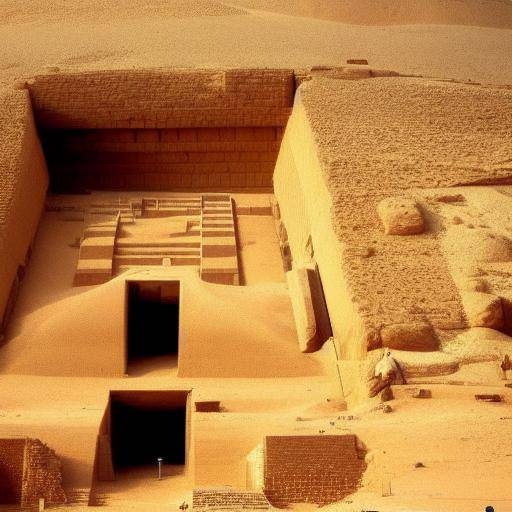
The Pyramids of Giza, located on the outskirts of Cairo, Egypt, are one of the oldest and most enigmatic architectural wonders in the world. These majestic structures, built thousands of years ago, have puzzled archaeologists, historians and enthusiasts alike, triggering debates and theories about their purpose, construction and meaning. In this article, we will explore seven mysteries of the Pyramids of Giza that will fascinate you and immerse you in the intriguing world of ancient Egypt.
History and Meaning
The Pyramids of Giza, composed of the Great Pyramid of Keops, the Pyramid of Kefrén and the Pyramid of Micerines, were built during the Fourth Dynasty of ancient Egypt, more than 4,500 years ago. These imposing funeral structures were erected as monumental tombs for the powerful Pharaohs, whose influence and legacy define much of Egyptian history.
Who were the Powerful Pharaohs?
The Pharaohs were supreme rulers of ancient Egypt, regarded as divine beings and with absolute power over their subjects. These leaders played a crucial role in the construction and development of Egyptian civilization, leaving a legacy of monumental achievements that included the construction of imposing pyramids, majestic temples and significant advances in agriculture, technology and religion.
The figure of the Pharaoh was central to Egyptian society, exercising a dominion marked by its military, political and religious divinity and might. The powerful Pharaohs, such as Keops, Kefrén and Micerinos, commissioned the construction of the Pyramids of Giza as eternal monuments that would ensure their immortality and position in the beyond.
Ancient Engineering: The Wonder of the Construction
The construction of the Pyramids of Giza challenges the conventional notions of engineering and architecture. These amazing structures were built using methods and techniques that, even today, are disconcerting for civil engineering experts. The mystery of how these giant pyramids were built has resisted the passage of time, generating speculations and theories that challenge modern understanding.
Ancient Technology: How were Pyramids built?
The creation of the Pyramids of Giza raises questions about the technological and organizational capacity of ancient Egyptian civilization. The precision with which they were cut, transported and assembled huge limestone and granite blocks to form these impressive structures is an enigma that still lacks a definitive explanation. The construction technique, the logistics of transporting distant quarry stones and the precise layout of each block in pyramids continue to amaze scientists and fans alike.
Egyptian astronomy: Heavenly and Earthly Mysteries
The relationship between the Pyramids of Giza and the Egyptian astronomy raises questions about the deep connection between the ancient Egyptians and the heavens. From precise astronomical alignments to supposed star representations in the disposition of pyramids, the influence of astronomy in the conception and construction of these monumental structures has generated intriguing theories and debates on their cosmic and spiritual purpose.
The Enigma of the Star Sewers
The precise alignments of pyramids with certain constellations and astronomical events have led to speculation as to whether pyramids were designed as astronomical observatories or as earthly representations of cosmological concepts. The precise disposition of the three pyramids in relation to the position of the stars has led to theories on the role of astronomy in the planning and construction of these majestic structures, implying an advanced understanding of the astronomical cycles and a deep reverence for the cosmos.
The Pyramids of Giza continue to be an inexhaustible source of astonishment and speculation, challenging our modern perceptions of the past, technology and the relationship between humanity and the universe. These architectural wonders not only represent the colossal achievements of ancient engineering and human ambition, but also embody a lasting legacy that continues to fascinate and disconcert modern generations.
Conclusion
The Pyramids of Giza embody a monumental legacy that transcends time and awakens the innate curiosity of humanity. Their persistent mysteries and their lasting meaning continue to invite explorations, research and reflections on the achievements and the worldview of ancient Egypt. As we immerse ourselves in the distant past, we find an amalgam of engineering, astronomy and culture that challenges expectations and lights our imagination. Throughout the centuries, the Pyramids of Giza have maintained their aura of mystery and greatness, reminding us that the splendour of ancient Egypt continues to resonate in the heart of humanity.
Frequently asked questions
Why were the Pyramids of Giza built?
The Pyramids of Giza were built as funeral monuments to house and protect the mortal remains of the powerful Pharaohs, ensuring their immortality in the beyond according to the Egyptian cosmovision.
How were the Pyramids of Giza built?
The construction of the Pyramids of Giza involved the carving, transport and elevation of huge limestone and granite blocks using ingenious techniques and a massive labor organization.
What role did astronomy play in building pyramids?
Egyptian astronomy influenced the alignments and disposition of Giza Pyramids, generating theories about their relationship with astronomical events and cosmic concepts.
What is the importance of the Pyramids of Giza in the history of humanity?
The Pyramids of Giza represent colossal milestones in the history of architecture, engineering and culture, highlighting the achievements and the worldview of ancient Egypt.
Is there evidence of the alien presence in the construction of pyramids?
There is no scientific or archaeological evidence supporting the theory of alien intervention in the construction of the Pyramids of Giza.
Will new secrets be discovered about pyramids in the future?
Continuous archaeological and technological research could reveal new details and meanings about pyramids, keeping alive the possibility of surprising discoveries in the future.
In exploring these mysteries of the Pyramids of Giza, we embark on a transformative journey that highlights the lasting grandeur of ancient Egypt and the continuing fascination it exerts on our imagination and understanding of the human past.
